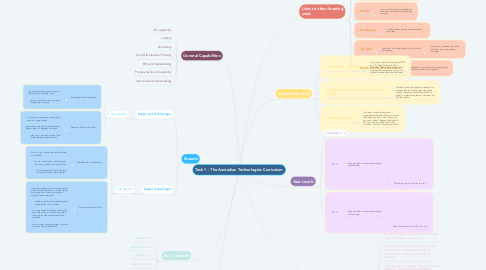
1. General Capabilities
1.1. ICT capability
1.2. Literacy
1.3. Numeracy
1.4. Critical & Creative Thinking
1.5. Ethical Understanding
1.6. Personal & Social Capability
1.7. Intercultural Understanding
2. Cross-curriculum priorities
2.1. Aboriginal & Torres Strait Islander Histories & Cultures
2.2. Asia and Australia's Engagement with Asia
2.3. Sustainability
3. Strands
3.1. Design and Technologies
3.1.1. Sub Strands
3.1.1.1. Knowledge & Understanding
3.1.1.1.1. the use, development and impact of technologies in people’s lives
3.1.1.1.2. design concepts across a range of technologies contexts
3.1.1.2. Processes & Production Skills
3.1.1.2.1. critiquing, exploring and investigating needs or opportunities
3.1.1.2.2. generating, developing and evaluating design ideas for designed solutions
3.1.1.2.3. planning, producing (making) and evaluating designed solutions
3.2. Digital Technologies
3.2.1. Sub Strands
3.2.1.1. Knowledge & Understanding
3.2.1.1.1. how data are represented and structured symbolically
3.2.1.1.2. the use, development and impact of information systems in people’s lives
3.2.1.1.3. the components of digital systems: software, hardware and networks
3.2.1.2. Process & Production Skills
3.2.1.2.1. collecting, managing and interpreting data when creating information, and the nature and properties of data, how they are collected and interpreted
3.2.1.2.2. defining problems and specifying and implementing their solutions
3.2.1.2.3. creating and communicating information, especially online, and interacting safely using appropriate technical and social protocols
3.2.1.2.4. using a range of digital systems and their components and peripherals
4. Key Concepts
4.1. Abstraction
4.2. Data Collection
4.3. Specification
4.4. Digital Systems
4.5. Interaction
5. Curriculum Aims
5.1. document design ideas and communicate these to a range of audiences
5.2. creatively, competently and safely in the development of designed solutions suitable for a range of technologies contexts
5.3. understand the roles and responsibilities of designers, technologists and those in related occupations
5.4. develop confidence as critical users and designers and producers of technologies and designed solutions
5.5. explore, investigate, create and critique innovative, ethical and sustainable designed solutions for preferred futures using a range of technologies
5.6. select and manipulate a range of materials, components, tools and equipment
6. Links to other learning areas
6.1. English
6.1.1. Describing, discussing, interpreting, writing, co-operating with peers, reading and giving instructions
6.2. Maths
6.2.1. Tables, lists, graphs and data skills
6.3. Science
6.3.1. draw on chemical, biological and physical science knowledge
6.4. History
6.4.1. draw on historical and contemporary sources to understanding technology evolution
6.5. Georgraphy
6.5.1. consider places, human significance and processes
6.6. The Arts
6.6.1. visual arts - line, shape, texture, form, colour and creating
6.6.1.1. media arts, - planning, producing, capturing, recording, editing, choosing
6.7. Health and Physical Education
6.7.1. application of movement and energy skills and how systems work together
7. Student Diversity
7.1. Students with a disability
7.1.1. In alignment with the Disability Act 1992 and the Disability Standards for Education 2005. activities need to be modified and adapted to cater for all children's needs within the classroom
7.2. English as an additional language or dialect (EAL/D)
7.2.1. Additional time and support is required for students whose first language may not be English. A teacher resource is available to assist in implementing lessons that cater for EAL/D students
7.3. Gifted and talented
7.3.1. Providing student's with greater opportunities that allows them to look at the subject content in more depth with the use of higher cognitive thinking skills. This can draw on content from cross curriculum priorities or higher year levels
8. Year Levels
8.1. Foundation - 2
8.2. 3 & 4
8.2.1. Blog post about a relevant app (digital technologies)
8.2.1.1. Tickle App: Learn to Code – lois carr
8.3. 5 & 6
8.3.1. Blog post about a relevant app (digital technologies)
8.3.1.1. Code Monster by Crunchzilla – lois carr
